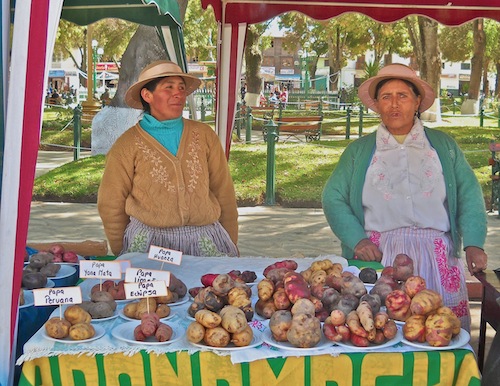 Silvia Sarapura is here in Guelph, completing her PhD in U of G’s rural studies program. But part of her is still back in Peru, high up in the Andes where she grew up and where she hopes her studies will help numerous families, especially women, to improve their own lives.
Silvia Sarapura is here in Guelph, completing her PhD in U of G’s rural studies program. But part of her is still back in Peru, high up in the Andes where she grew up and where she hopes her studies will help numerous families, especially women, to improve their own lives.
Her main tool is the potato, native to the South American highlands, where thousands of native varieties are grown today. Compare that to the handful of different kinds of spuds you might find at your grocery store or farmer’s market.
But Peru’s potatoes are not just diverse; they’re also deeply rooted. For some 8,000 years, potatoes have been cultivated there and in neighbouring Bolivia.
Now Sarapura, a trained agronomist, and her supervisor ─ Prof. Jim Mahone, School of Environmental Design and Rural Development (SEDRD) ─ see those native potatoes as the key to increased prosperity for thousands of rural people literally scratching at the fertile soil way up the mountainsides.
In cool, dry conditions about 4,000 metres above sea level, numerous small-scale farmers tend potato plots often no bigger than an Olympic-sized swimming pool. Many wield the same implements used there for generations, including a wooden foot plow called a chaquitaclla that was developed by the Incas.
Many of the mountain farmers are Incan descendants, including the Quechua people. Sarapura speaks the Quechua language, plus another indigenous language and Spanish. That has helped her during yearly field trips to the Andes to document the farmers’ way of life and to help growers find new markets.
Most of those growers are women. As in other rural parts of the world, it’s women who cultivate the crop. Some men tend farms as well, Sarapura says, but many look for work elsewhere, including mining.
Last fall, she spoke at Guelph about market chains in the Peruvian Andes and the role of women in producing and selling potatoes. She’s analyzing market opportunities for the crop from a female feminist perspective. “Women have preserved the species,” says Sarapura, referring to potato genetic diversity.
Potatoes are the third-largest food crop in the world, behind wheat and rice; corn is fourth.
The largest potato-producing countries are China and India.
In Peru, some farmers grow their crop only for subsistence or for exchange for other crops and commodities. Others sell their produce at farmers’ markets. Still others are more ambitious, hoping to sell potato products nationally and even to international markets like North America.
A few are taking part in a project of the Lima-based International Potato Centre (known by its Spanish acronym, CIP). That initaitive aims to connect farmers and urban markets and to improve the quality of commercial potato products, such as dried and dehydrated potatoes, flour and tocosh, a traditional Quechua food with antibiotic properties.
“They want to be known in order to open new markets,” says Sarapura. That includes Canada, known to many Peruvians through the Canadian International Development Agency and the International Development Research Centre.
During her three-month-long visits, she provides information and advice to help those growers learn about export opportunities ─ perhaps through companies looking for new processed products. But she also offers training and development by talking to women and girls about business, education, communication and public speaking, leadership, and skills training.
Mahone calls his student a facilitator. “She’s causing trouble,” he says, tongue in cheek. “She’s providing motivation to bring about changes.”
Sarapura is also documenting the project through a research blog and in video. Her husband, Guillermo, has helped to record the lives of Peruvian farmers. Sarapura says they produced the video below “with pictures we took of different women and men who cultivate native potato. We consider it as a tribute to their work and dedication to sustainable agriculture and biodiversity.”
One of Sarapura’s favourite subjects is Nelly Escurra, 41. Although she went only as far as the third grade, Escurra is now renting and cultivating more land with potatoes, and is able to send her own three children to school.
“The whole idea is to document how people are living there,” says Mahone, whose own research interests involve capacity development and extension. “Even the Peruvian government doesn’t pay attention.”
Sarapura’s family lives in Matahuasi, an Andean village almost 200 kilometres inland from Lima. The village is considered a centre of agriculture and livestock production. Her family runs a 100-hectare farm raising livestock and growing potatoes for commercial sale. Her father and brother are also agronomists.
After studying agronomy in Peru, she worked on plant breeding at the International Potato Centre in Lima. Sarapura started her PhD in 2008. Her co-adviser is Graham Thiele at the CIP.
Her talk at Guelph, called “Native Potato: Ensuring the Planet’s Food Security,” included a presentation by Peter VanderZaag, an Ontario potato farmer and chair of the CIP’s board of trustees. He’s also vice-president of the Roots for Life Foundation, a fundraising campaign to help conserve the thousands of native potato varieties held in the CIP gene bank. The campaign began in October to mark the 2010 United Nations International Year of Biodiversity.